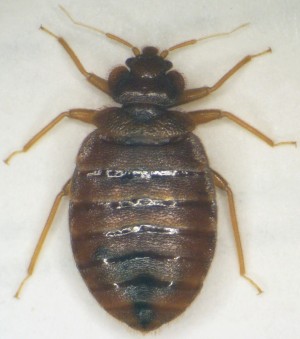 Learn About Bed Bugs Before You Travel - April 23, 2014 Jeff Schalau, Agent, Agriculture & Natural Resources University of Arizona Cooperative Extension, Yavapai County By now, you’ve probably heard about the increasing occurrence of bed bugs (Cimex lectularius) in the industrialized world. Scientists believe this is partly due to their growing resistance to pyrethrin-based insecticides licensed for indoor use. This occurs after insect populations are repeatedly exposed to a particular pesticide. Exposed survivors are assumed to have some resistance to the pesticide and they breed with other survivors making them increasingly resistant to the pesticide used. We have known about pesticide resistance for decades and the solution is to utilize a broad range of management strategies which include varying the type of pesticide used and incorporating non-pesticide management strategies whenever possible. Some pest control operators have started using bed bug–sniffing dogs to locate them and heat treatment to kill them. Pesticides are also used, but in conjunction with other methods. This is called “integrated pest management” or IPM and it can and should be applied to all pest management situations. Scientists are also realizing that bed bug infestations cannot be managed by simply applying technology. Everyone needs to learn to recognize bed bugs and their telltale signs if they are to be avoided while travelling and if they are present in your home. Contrary to popular belief, they can be in any lodging – be it a posh resort or discount motel. Here, they can enter your luggage or other items and hitchhike home with you or to the next hotel. They can also be in used beds, bedding, furniture and other items we may bring into our homes. Kids can also bring them to school in their backpacks or on jackets where they can find harbor in other’s belongings and hitchhike to non-infested homes. Most entomologists I know strip the bed sheets and inspect cracks and crevices before moving into a motel/hotel room. Some also place their luggage in the bathtub as this is an unlikely place for bed bugs to be harbored. Those folding luggage stands are a good idea, but they can also harbor bed bugs or allow them to enter your luggage if it is in contact with the wall or floor. Most hotels and motels are hyper-aware of the bed bug issue and will take action and provide refunds when bed bugs are positively identified. However, the average person may not have the knowledge and/or experience to correctly identify them. In my work as Yavapai County Agricultural Extension Agent, I have identified bed bugs in Yavapai County on multiple occasions. The number of calls we receive on them has increased in the last three years. There are also other similar-appearing Cimex species (there are over 100) that parasitize birds and bats. These insects will also feed on humans and pets in the absence of their preferred hosts. Briefly, bed bug eggs are about 1/32 inch across. Adults are brown, wingless, oval in shape, flattened and about 3/8 inch long. Immature bed bugs are about 1/8 inch long and cream colored until they have had a blood meal. Bed bug excrement is black or brown and the size of sand grains. However, to better recognize them, you really need to look at photos and learn to recognize their telltale signs. In addition, it is difficult to identify bed bugs just by looking at bites. You really need to capture the insect in a jar or sealable plastic bag and bring it to the Cooperative Extension office or other knowledgeable authority. Below are links to publications that show bed bug eggs, immature and mature insects, excrement, and other forms of evidence with the on-line version of this column (see URL below). It is critically important to learn to identify them – especially if you travel frequently. If you have encountered bed bugs during a trip, unpack outdoors, bag infested clothing and bedding before you put it in your vehicle or enter your home, and place it directly in a washer and/or dryer. Your luggage can be shaken out, vacuumed, heat treated, or laundered depending on the materials. You may also want to know about a website called The Bedbug Registry (bedbugregistry.com). This site allows users to enter observations and anecdotal information about bed bug encounters – real or perceived. Many of the entries are from customers reporting on their lodging experiences. It also allows proprietors and pest control companies to respond to the entries in a “blog” format. While some of the information may be erroneous, you can read it, consider the source, and make your lodging decisions accordingly. Follow the Backyard Gardener on Twitter – use the link on the BYG website. If you have other gardening questions, call the Master Gardener help line in the Camp Verde office at 928-554-8999 Ext. 3 or e-mail us at verdevalleymg@gmail.com and be sure to include your name, address and phone number. Find past Backyard Gardener columns or provide feedback at the Backyard Gardener web site: http://cals.arizona.edu/yavapai/anr/hort/byg/. Additional Resources Bed Bugs (University of Kentucky Cooperative Extension Factsheet) www.ca.uky.edu/entomology/entfacts/ef636.asp Prevention and Control of Bed Bugs in Residences (University of Minnesota Extension Factsheet) www.extension.umn.edu/distribution/housingandclothing/DK1022.html |